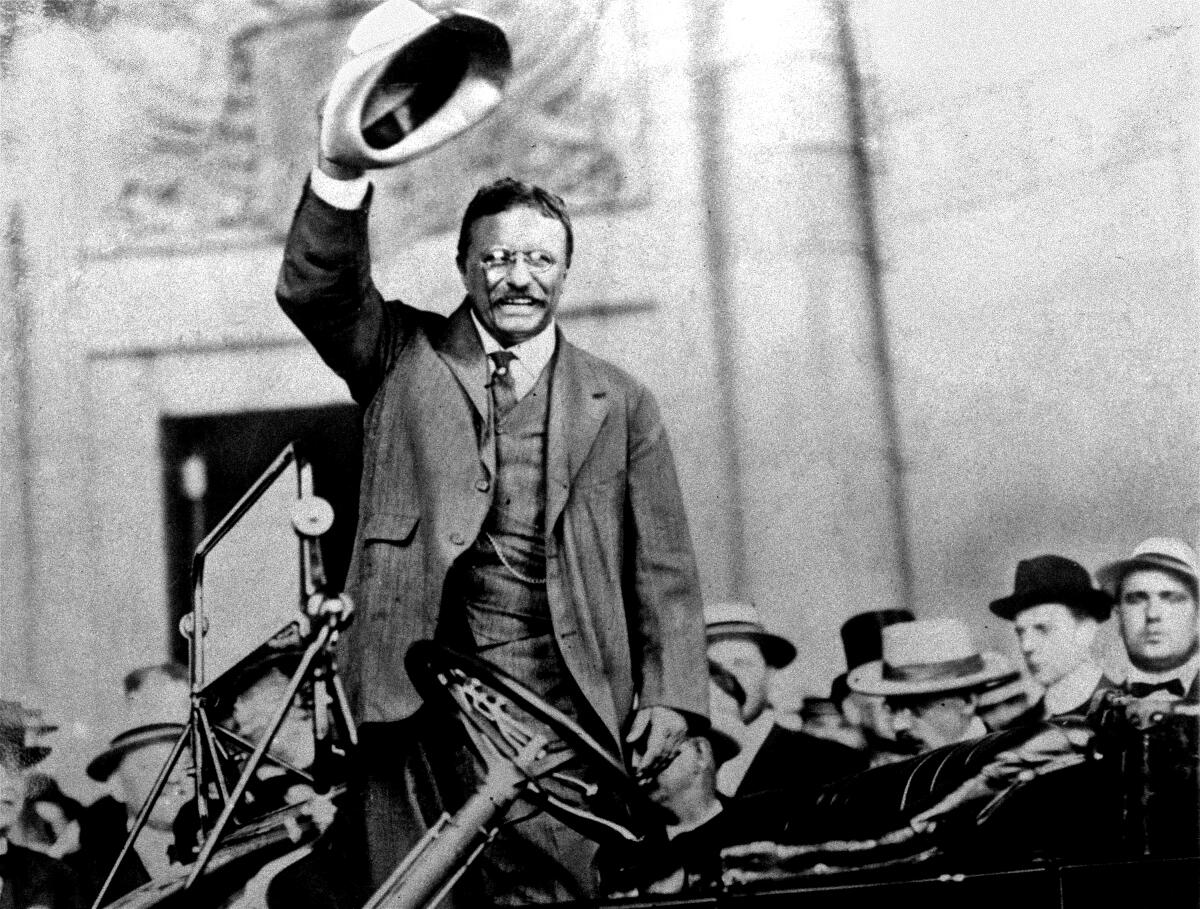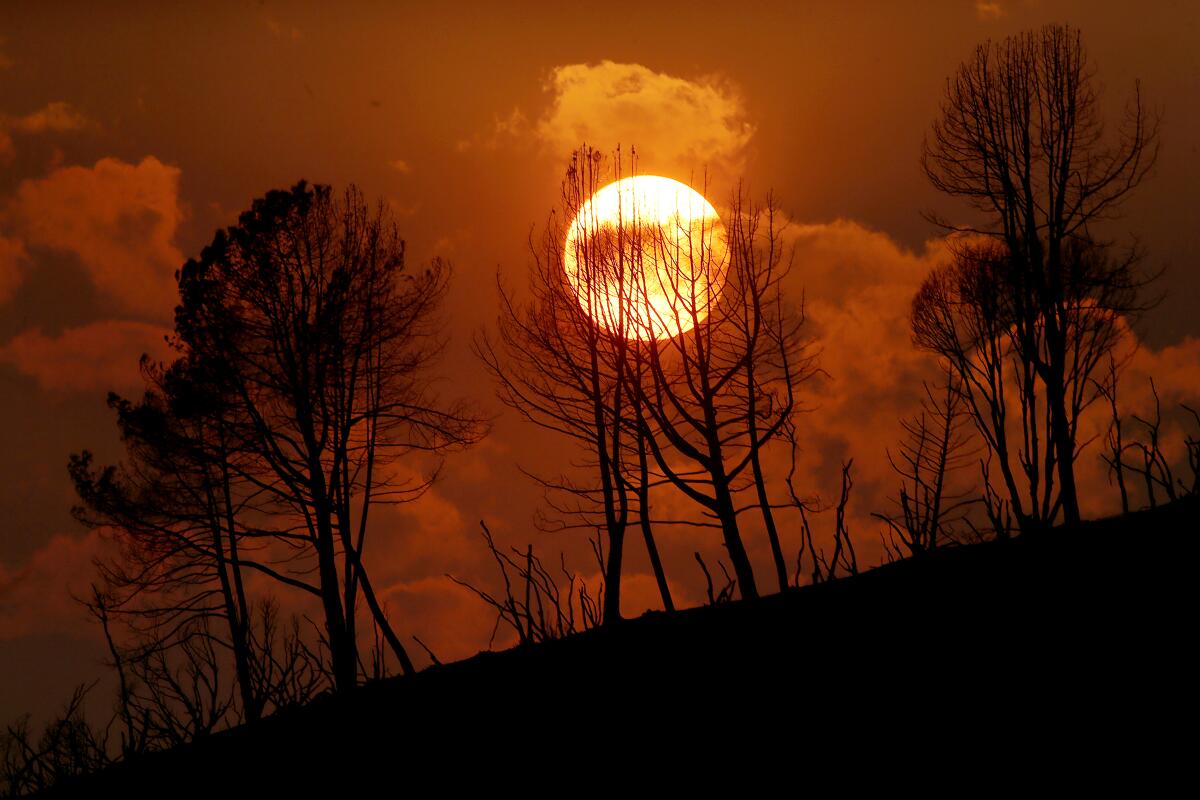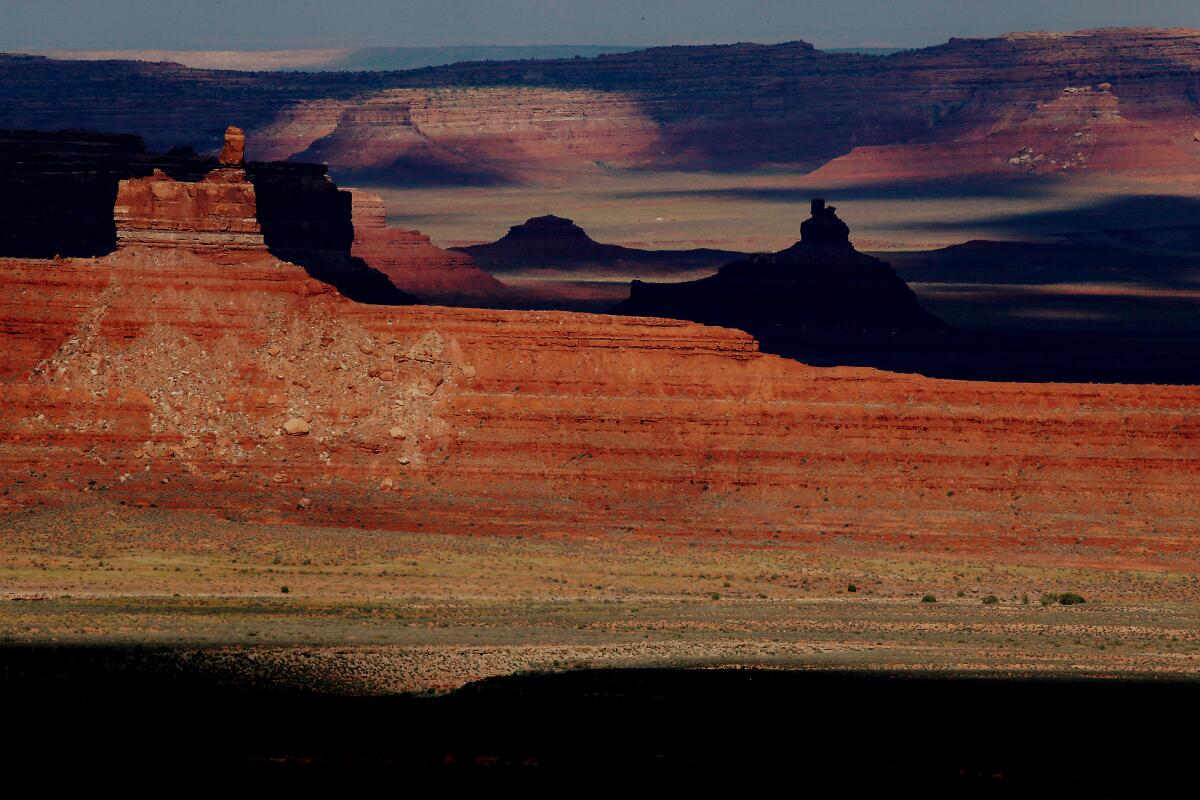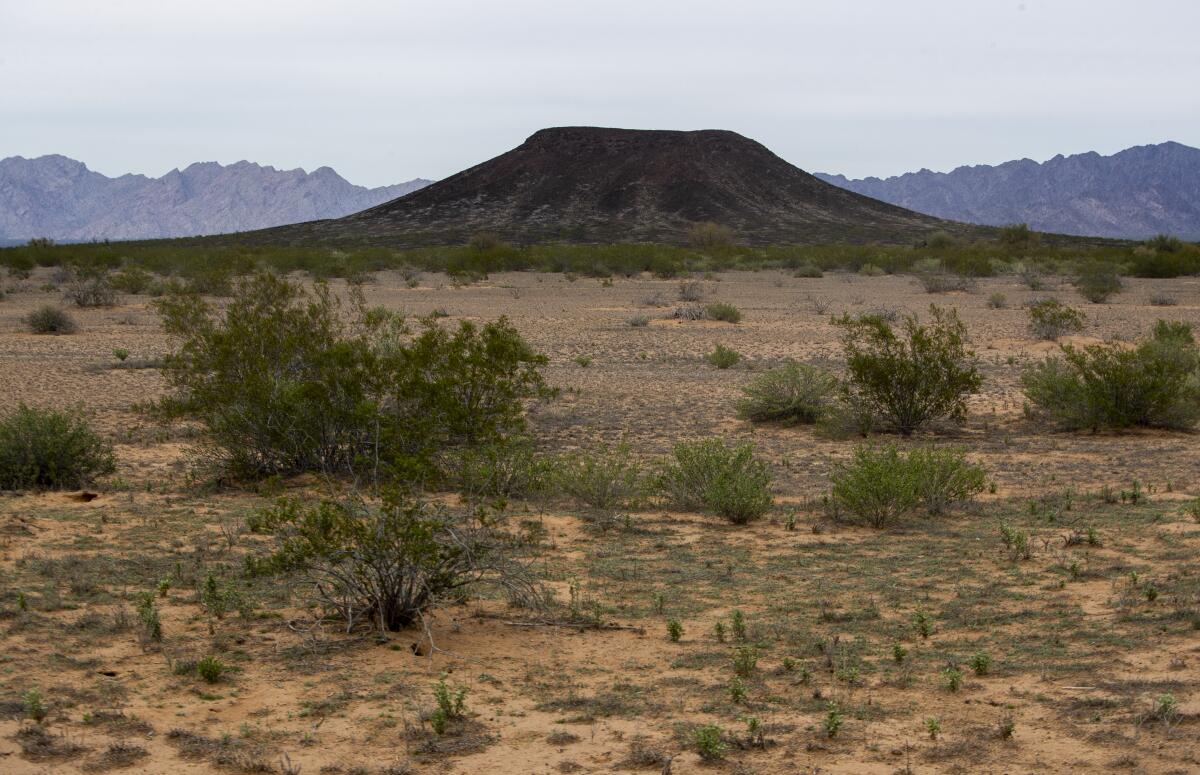Boiling Point: What would Teddy say?

- Share via
This story was originally published in Boiling Point, a newsletter about climate change and the environment. Sign up here to get it in your inbox.
“The forest and water problems are perhaps the most vital internal questions of the United States.”
So said President Theodore Roosevelt in his First Annual Message to Congress on Dec. 3, 1901, as quoted in historian Douglas Brinkley’s “The Wilderness Warrior.” I’ve been making my way through the conservation-focused biography, published in 2009, and finding myself fascinated by how many of Roosevelt’s insights into the environmental challenges of the American West still hold true today — even as others feel anachronistic at best and irredeemably racist at worst.
“When I hear of the destruction of a species I feel just as if all the works of some great writer had perished,” Roosevelt wrote.
The 26th president fought to protect wildlife — and yet he urged the construction of dams and reservoirs that would allow for tens of millions of people to move West, with seemingly little regard for the fish whose habitat would be blocked, or the Native American tribes who had forged a sacred bond with those fish over many millennia.
The consequences of that callous attitude are still being felt today.
Eight decades after the construction of Shasta Dam — built by a federal agency that Roosevelt brought into being — California has agreed to partner with the Winnemem Wintu Tribe to try to restore wild salmon in the McCloud River above the dam, my colleague Ian James reports. Farther north, Seattle City Light will upgrade its Skagit River dams to help fish reach their historic spawning grounds — but the utility won’t heed tribal calls to tear down the dams, the Seattle Times’ Isabella Breda writes.
“The preservation of our forests is an imperative business necessity,” Roosevelt told Congress in 1901. “We have come to see clearly that whatever destroys the forests, except to make way for agriculture, threatens our own well-being.”
Extremely true — at least in part.
Yes, intact forests and other public lands are crucial to recreation, biodiversity and ultimately human health — and Roosevelt did more to protect those lands than maybe any other commander in chief. But the culture of aggressive firefighting that Roosevelt and his appointees helped foster has resulted in overgrown forests primed to burn — especially as the planet warms.
Once again, we’re feeling the consequences today. The Times’ Alex Wigglesworth wrote this week about the Southern Sierra Miwuk Nation, who a century and a half ago were kicked out of their ancestral lands in the Yosemite region by white settlers and barred from practicing traditional burns — an injustice that has helped fuel today’s destructive fires through the national park.

And as for Roosevelt’s beloved wildlife? Although big fires can devastate rivers and the creatures swimming in them, research shows that a moderate amount of fire, like we’ve had historically, can be beneficial to fish health, KQED’s Danielle Venton reports.
Then there’s Roosevelt’s comment that destroying forests “to make way for agriculture” is actually a good thing.
Agriculture makes the world go round, supplying the eggs and potatoes and avocados for the breakfast burrito I’m enjoying as I write this. But cutting down trees to make way for farming releases massive amounts of carbon into the atmosphere, fueling the climate crisis. And ranching — a beloved pastime for Roosevelt — is also a significant driver of global warming, with cows and other livestock emitting large amounts of methane, a heat-trapping gas more powerful than carbon dioxide.
Not that Big Beef wants you to realize that. I was fascinated reading this piece by Joe Fassler for the Guardian, exploring the meat industry’s “Masters of Beef Advocacy” program — part of a 24/7 messaging machine meant to counter unfavorable science.
“We have taken forward steps in learning that wild beasts and birds are by right not the property merely of the people alive today, but the property of the unborn generations, whose belongings we have no right to squander,” Roosevelt said.
The tension between preserving public lands for future generations and exploiting them for resources today continues to divide Americans — with climate change adding further strain. The Biden administration is trying to thread the needle with a new plan to offer “conservation leases” to make up for damage caused by energy development, mining, grazing and more — but whether the plan succeeds or fails will largely depend on how it’s implemented, HuffPost’s Chris D’Angelo reports.
“To Roosevelt, the West was the best hope for America,” Brinkley writes.
On a road trip last year, I passed through Roosevelt City, Utah, named for Teddy. The town bills itself as the “energy hub of Utah,” and its logo features an oil pumpjack. There’s a bust of Roosevelt outside City Hall, and a portrait inside the building.
“It is not the critic who counts, not the man who points out how the strong man stumbles, or where the doer of deeds could have done them better,” reads a Roosevelt quote displayed in the reception area. “The credit belongs to the man who is actually in the arena, whose face is marred by dust and sweat and blood.”
In the climate change era, we’re all in the arena, whether we like it or not. Let’s keep up the good fight.
Here’s what else is happening around the West:
POLITICAL CLIMATE

The California Foundation on the Environment and the Economy has quietly become one of the most influential behind-the-scenes forces in Sacramento, spending more than any other interest group on educational trips and conferences for legislators and state officials. That’s according to an eye-opening investigation from CalMatters’ Jeremia Kimelman and Alexei Koseff. They write that the group’s board of directors brings together “92 somewhat strange bedfellows, including major corporations, oil companies, environmental groups, construction trade unions, public utilities and water districts.”
Jay Inslee won’t run for a fourth term as Washington governor — but he’s signing a bunch of climate legislation on the way out the door. Details here from Annette Cary at the Tri-City Herald. One of the bills is designed to speed up the permitting process for renewable energy projects, while also enshrining early input from nearby communities and Indigenous tribes.
California condors are an Endangered Species Act success story — but now a dangerous strain of bird flu threatens to undo decades of progress. Here’s the story from The Times’ Louis Sahagún, who writes that the birds “are facing a biological catastrophe they may not be able to overcome.” In other wildlife news, the U.S. Senate voted 50 to 48 to undo Endangered Species Act protections for the lesser prairie chicken — a vote that has implications for oil and gas production in New Mexico and Texas. President Biden has vowed to veto the Senate resolution, Ariana Figueroa reports for States Newsroom. Meanwhile, federal officials are once again considering Endangered Species Act protections for the bi-state sage grouse, along the Sierra Nevada’s eastern front in California and Nevada, per Scott Sonner at the Associated Press.
THE ENERGY TRANSITION
Japanese Americans say a proposal for Idaho’s biggest wind farm would disrupt historic views from Minidoka National Historic Site, which commemorates a World War II-era prison camp. The Washington Post’s Dino Grandoni wrote about the opposition to LS Power’s proposed Lava Ridge wind farm, which is one of several potential stumbling blocks to Idaho Power’s plans for 100% clean energy in the Gem State — a topic that the Idaho Statesman’s Ian Max Stevenson explored in more detail here. Stay tuned for my own deep dive into Idaho’s energy transition in the next few months, part of Repowering the West.
Bill Gates spent some time in Kemmerer, Wyo., to pitch the town on his next-generation nuclear reactor. Local residents are hopeful the billionaire investor’s nuclear aspirations can help replace jobs and tax revenues from the fading coal industry, Nicole Pollack writes for the Casper Star-Tribune. Another planned coal-plant closure has residents of Craig, Colo., wondering if dinosaur tourism can help the town recoup some of its expected economic losses, Derek Maiolo writes for High Country News.
New York just became the first state to ban gas hookups in new buildings, eclipsing California in a key climate-policy arena. The budget signed by Gov. Kathy Hochul “will prohibit fossil fuel equipment and building systems in new construction, phase out the sale and installation of fossil fuel space and water heating equipment in existing buildings, and establish building benchmarking and energy grades,” according to the governor’s website. My colleague Terry Castleman has more.
ENVIRONMENTAL JUSTICE

A company has staked claims to mine uranium on federal lands in Utah, just outside Bears Ears National Monument — lands that Indigenous tribes originally proposed for inclusion in the monument. And because of the Mining Law of 1872, federal officials couldn’t say no even if they wanted to, the Salt Lake Tribune’s Brian Maffly reports. In New Mexico, another firm wants to mine uranium in an area already burdened with pollution from past extraction of the radioactive element — and the Navajo Nation might not be able to stop it, Hannah Grover writes for NM Political Report.
Southeast Los Angeles yards are plagued by toxic lead from the closed Exide Technologies battery recycling plant — and a dusting of zeolite could help. The mineral can adsorb lead from soil, and researchers are testing out how effective it can be if they sprinkle it on affected lawns, my colleague Nathan Solis reports. As The Times has reported previously, state officials have in many ways dropped the ball on cleaning up lead pollution in these largely Latino, low-income neighborhoods.
Decades after government planners purposely built freeways through Black neighborhoods in the San Francisco Bay Area, West Oakland residents are still grappling with air pollution that raises the odds of getting cancer. Here’s the story from the Washington Post’s Darryl Fears and John Muyskens, who write that West Oakland “is hardly the Bay Area’s only example of blatant segregation and environmental inequity,” with the city of Richmond and San Francisco’s Hunters Point neighborhood “forming a triangle of pollution in a region that has long touted its progressive credentials.”
WATER IN THE WEST
As if climate change worsening our swings from drought to flood and back weren’t enough, we’ve also got to be wary of hackers taking over water systems and turning off treatment plants. That’s the takeaway from this piece by The Times’ Hayley Smith, who writes that many water utilities in California and nationwide “are still operating with outdated software, poor passwords, aging infrastructure and other weaknesses that could leave them at risk.” Smith also wrote about why we can’t let our guard down on efforts to protect against wildfires, even after all the recent rain. Fire season will be here before long.
Vidler Water Co. has spent decades securing Western water rights — and it was acquired last year by D.R. Horton, the nation’s largest home builder. The purchase could help spur suburban growth across the region — or hasten the moment when the Western growth machine grinds to a halt, Grist’s Jake Bittle warns in a fascinating investigation. In other water scarcity news, the Arizona Republic’s Stacey Barchenger reports that state officials revoked permits that would have allowed a Saudi Arabian company to drill two more groundwater wells. The company grows alfalfa in Arizona to feed its cows in the Middle East.
Rural school districts are being forced to jump through all sorts of hoops as they struggle to rebuild — and help kids maintain a sense of normalcy — after destructive storms in California. “The costs have quickly added up: New roofs. New drywall. New carpet. Mold testing. Water quality testing,” my colleague Hailey Branson-Potts writes in her story. And with most of the Golden State’s colossal snowpack yet to melt, the worst flooding could be yet to come, Hayley Smith reports.
AROUND THE WEST

“We tend to think of deserts as super resilient, but what global research is now finding ... is that these ecosystems are actually very fragile, and they’re actually responding really quickly to changes in climate.” That’s what a UC Riverside researcher told the Desert Sun’s Erin Rode, describing a new study finding that Sonoran Desert trees and plants are shifting their habitats as temperatures rise, often creeping up into the mountains — and in many cases not thriving in their new habitats.
Proposals for new national monuments are popping up all over the American West, as tribes and conservationists look to persuade the Biden administration that their sacred, special places deserve protection. This week, the Colorado Sun’s Jason Blevins wrote about a campaign to preserve the Dolores River, a Colorado River tributary that even far-right Rep. Lauren Boebert thinks is in need of some form of protection. In Nevada, meanwhile, political leaders are urging President Biden to designate the Swamp Cedars north of Great Basin National Park — a holy site for tribes, known as Bahsahwahbee in Shoshone — as a national monument. Jessica Hill at the Las Vegas Review-Journal has the details.
“They entered, at last, the Grand Canyon. The date was July 13, 1938.” So begins a spellbinding story by Melissa L. Sevigny for High Country News, telling the tale of two women who ran the Colorado River nearly a century ago, conducting the first botanical study of the Grand Canyon by Western scientists — and somehow managing to cook for their crew, too. The piece was excerpted form Sevigny’s new book, “Brave the Wild River,” which will be published on May 23.
ONE MORE THING

As regular readers of this newsletter probably know, I’m a big Disney fan, and I’ve been closely following the battle between the Walt Disney Co. and Florida Gov. Ron DeSantis. The latest development includes yet another environmental connection, with the Orlando Sentinel’s Skyler Swisher reporting that Florida lawmakers voted to give the state inspection authority over the Disney World monorail — once envisioned to be part of a sustainable, futuristic city and clean transportation network.
Most of that vision never came to pass — but the monorail did. And like everything else, it’s become political fodder.
We’ll be back in your inbox on Thursday. To view this newsletter in your Web browser, click here. And for more climate and environment news, follow @Sammy_Roth on Twitter.
Toward a more sustainable California
Get Boiling Point, our newsletter exploring climate change, energy and the environment, and become part of the conversation — and the solution.
You may occasionally receive promotional content from the Los Angeles Times.






